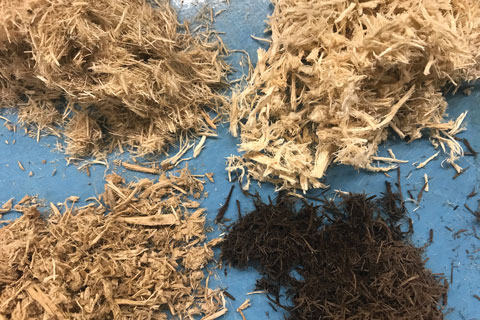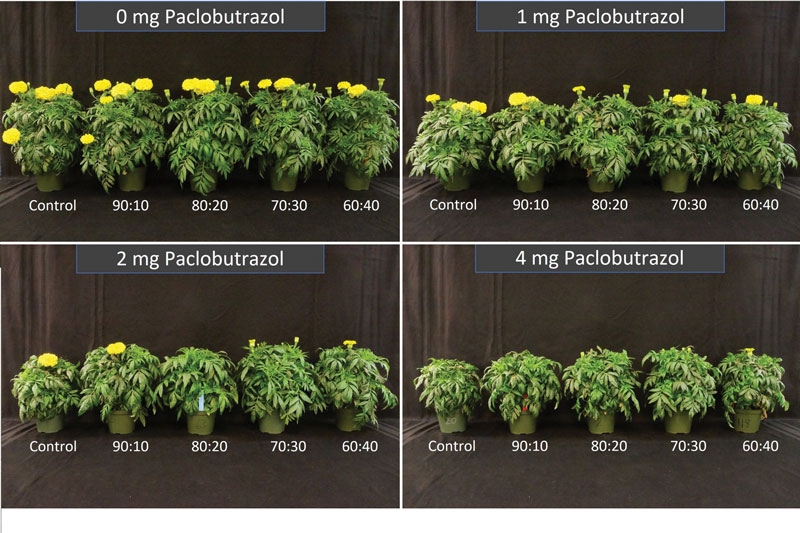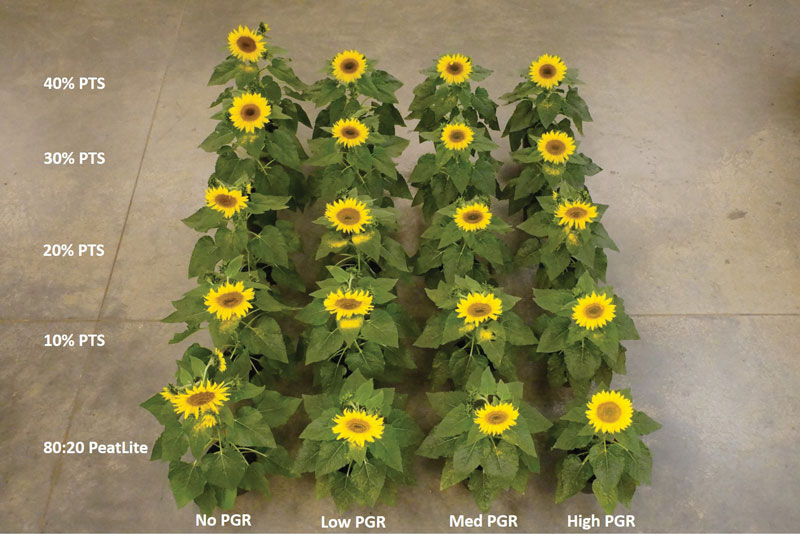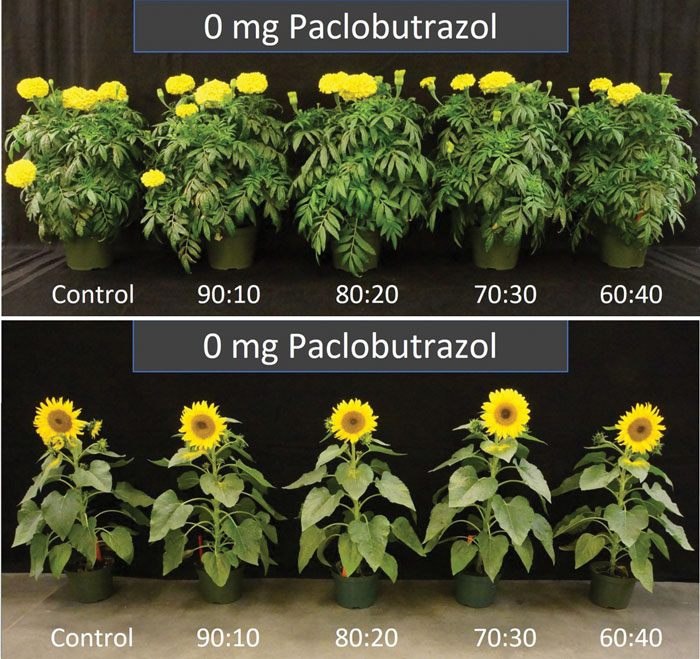2/1/2019
A Good Partnership
Dr. Brian E. Jackson & Turner Smith

PGRs to produce uniform, compact plants in greenhouses is common practice in the floriculture industry. The primary benefit of PGRs is to control excessive growth allowing tighter spacing and increased yield per growing area. A variety of methods are utilized to apply PGRs, including liner soaks, bulb dips, foliar sprays, spike applications and substrate drenches.
Figure 1. Different types of commercial wood substrate materials are available in North American and European markets, most being fiberous in texture/structure.
One of the most popular application methods are substrate drenches. A drawback of drench applications is the potential adsorption of active ingredient by organic substrate components. Aside from vermiculite and perlite, most of the substrate components used today are comprised of organic materials. For this reason, many researchers have examined PGR efficacy in a range of horticultural substrates, notably pine bark (aged or composted), rice hulls and coconut coir.
As the adoption and use of wood substrate components has increased over the past several years, so has the need for specific research on the many production parameters of crops grown in these substrates. In the past, loblolly pine wood chips (Pinus taeda) were reported to have no influence on paclobutrazol efficacy when used as a perlite replacement in peat-based substrates. Other works have reported that distilled red cedar (Juniperus virginiana) and Wholetree (ground whole loblolly pine trees) had mixed plant growth and PGR efficacy results.
Since these trials were conducted and published, the use of other types of wood components has increased, most being fiberous in nature (Figure 1). These fibrous wood materials may have a higher surface area than the original wood materials tested, so it’s uncertain if they interact with PGRs differently.
Due to the growing popularity of wood fiber, wide use of PGR substrate drenches and lack of scientific literature explaining how wood fiber may affect these substrate drenches, it was the objective of this study to examine a fiberous pine tree substrate (PTS) material and PGR efficacy in the production of marigolds and sunflowers.
T he study
he study
For substrate formulations, Canadian sphagnum peat was fluffed and wetted by hand before being amended with PTS at 90:10, 80:20, 70:30 and 60:40 (by volume), respectively. (The PTS was produced from freshly harvested 14-year-old loblolly pine trees that were double shredded, stored for one month, then hammer-milled at 3,000 rpm through a ¼-in. screen.) A peat and perlite (80:20) mix was also used in this study as a control.
Figure 2. Marigold growth in 80:20 peat-perlite control and peat, plus increased percentages of fresh pine tree substrate 10% to 40% with no (0 mg), low (1 mg), medium (2 mg) or high (4 mg) active ingredient of Paclobutrazol.
All substrates were hand wetted to a moisture content of 55% and had the pHs adjusted similarly to 5.8. Marigold and sunflower plugs were transplanted into 6-in. plastic containers and subsequently fertilized at each watering with 150 ppm nitrogen. Two weeks after transplanting, 3 fl. oz. of solution containing either 0, 1, 2 or 4 mg of active ingredient (a.i.) per container paclobutrazol was applied to each container as a substrate drench. After full anthesis for each species, plant growth parameters (including dry weight) were assessed. (Only dry weight data and visual observations will be discussed in this article.)
 For marigolds, height decreased as the PGR rate increased, as expected (Figure 2). The interesting aspect is that control plants (grown in peatlite) showed greater growth control at each rate than did the marigolds grown in all percentages of PTS. The percent increase in growth was minimal at some of the PTS percentages, but the trend was consistent across PGR rates.
For marigolds, height decreased as the PGR rate increased, as expected (Figure 2). The interesting aspect is that control plants (grown in peatlite) showed greater growth control at each rate than did the marigolds grown in all percentages of PTS. The percent increase in growth was minimal at some of the PTS percentages, but the trend was consistent across PGR rates.
Figure 3. Sunflower growth in 80:20 peat-perlite control and peat, plus increased percentages of fresh pine tree substrate 10% to 40% with no (0 mg), low (1 mg), medium (2 mg) or high (4 mg) active ingredient of Paclobutrazol.
In slight contrast, similar PGR studies also conducted in 2018 (on the same, plus different, species not reported in this article) showed similar growth control between peatlite and PTS blends across the same PGR rates. It’s uncertain (and not proven) if the wood components were responsible for “tying up” the PGR or if other factors were at play. It seems as though the time of year affecting the rate and speed of growth of plants may have influenced the overall total growth control.
For sunflowers, the plants grown in peatlite and all PTS blends showed the same height and size control across all PGR rates (Figure 3). Growth indices and dry weights were similar for plants across all substrates at each of the PGR rates.
The results
In these trials, we were pleased to see that even at the 0 PGR application rate, plant size and quality were the same (or larger) for plants grown in all treatments for both species (Figure 4). The marigolds were actually larger (higher dry weight values) in all PTS substrate blends (10% to 40%) compared to the plants grown in the peatlite control. This is especially notable considering these plant trials were fertilized with 150 ppm nitrogen and the wood percentages reached up to 40%.
 Previous research reports indicated similar growth of plants in PTS compared to perlite controls fertilized at 200 ppm, but not any lower. We believe that based on the age of pine wood used, the storage time of the processed PTS prior to blending and use in these trials, and the particle size of the wood material are reasons why no apparent nitrogen tie-up was observed. Wood that’s fresh, unaged or stored, produced with different manufacturing equipment/process, or of different size may indeed tie up (immobilize) nitrogen during crop production. This is one of the main hesitations for using fresh wood components in substrates.
Previous research reports indicated similar growth of plants in PTS compared to perlite controls fertilized at 200 ppm, but not any lower. We believe that based on the age of pine wood used, the storage time of the processed PTS prior to blending and use in these trials, and the particle size of the wood material are reasons why no apparent nitrogen tie-up was observed. Wood that’s fresh, unaged or stored, produced with different manufacturing equipment/process, or of different size may indeed tie up (immobilize) nitrogen during crop production. This is one of the main hesitations for using fresh wood components in substrates.
Figure 4. Marigold and sunflower growth in 80:20 peat-perlite control and peat, plus increased percentages of fresh pine tree substrate 10% to 40% when fertilized at 150 ppm nitrogen with no (0 mg) PGR applications.
Much remains to be understood about nitrogen use and general fertility practices in substrates containing wood. Growers who used more than 30% wood products in their mixes should continue to closely monitor crop nutrition and fertility needs. During these PGR trials, and replication of these trials, the similarity in substrate physical properties (air and water) between PTS and perlite were also similar (except for the highest 40% amendment), meaning that PGR drench applications and general irrigations were similar for all plants in most substrates. These trials also provide further evidence of the success that growers can have with perlite-free mixes. GT
Dr. Brian E. Jackson is an Associate Professor and Director of the Horticultural Substrates Laboratory at North Carolina State University. Brian can be reached at Brian_Jackson@ncsu.edu. Turner Smith is a former graduate student in substrate science at NC State University.